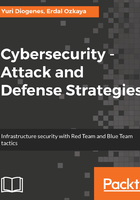
What this book covers
Chapter 1, Security Posture, defines what constitute a secure posture and how it helps in understanding the importance of having a good defense and attack strategy.
Chapter 2, Incident Response Process, introduces the incident response process and the importance to have one. It goes over different industry standards and best practices for handling the incident response.
Chapter 3, Understanding the Cybersecurity Kill Chain, prepares the reader to understand the mindset of an attacker, the different stages of the attack, and what usually takes place in each one of those phases.
Chapter 4, Reconnaissance, speaks about the different strategies to perform reconnaissance and how data is gathered to obtain information about the target for planning the attack.
Chapter 5, Compromising the System, shows current trends in strategies to compromise the system and explains how to compromise a system.
Chapter 6, Chasing a User's Identity, explains the importance of protecting the user's identity to avoid credential theft and goes through the process of hacking the user's identity.
Chapter 7, Lateral Movement, describes how attackers perform lateral movement once they compromise one system.
Chapter 8, Privilege Escalation, shows how attackers can escalate privileges in order to gain administrative access to the network system.
Chapter 9, Security Policy, focuses on the different aspects of the initial defense strategy, which starts with the importance of a well-created security policy and goes over the best practices for security policies, standards, security awareness training, and core security controls.
Chapter 10, Network Segmentation, looks into different aspects of defense in depth, covering physical network segmentation as well as the virtual and hybrid cloud.
Chapter 11, Active Sensors, details different types of network sensors that help the organizations to detect attacks.
Chapter 12, Threat Intelligence, speaks about the different aspects of threat intelligence from the community as well as from the major vendors.
Chapter 13, Investigating an Incident, goes over two case studies, for an on-premises compromised system and for a cloud-based compromised system, and shows all the steps involved in a security investigation.
Chapter 14, Recovery Process, focuses on the recovery process of a compromised system and explains how crucial it is to know what all options are available since live recovery of a system is not possible during certain circumstances.
Chapter 15, Vulnerability Management, describes the importance of vulnerability management to mitigate vulnerability exploitation. It covers the current threat landscape and the growing number of ransomware that exploits known vulnerabilities.
Chapter 16, Log Analysis, goes over the different techniques for manual log analysis since it is critical for the reader to gain knowledge on how to deeply analyze different types of logs to hunt suspicious security activities.